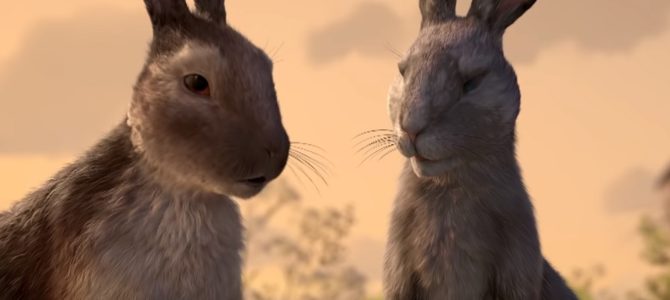
Netflix has released its long-anticipated miniseries of “Watership Down,” a co-production with the BBC. It’s the second animated rendition of the beloved 1972 Richard Adams adventure novel, about a group of rabbits who leave their endangered warren and venture on a hazardous quest to make a new home.
Fiver, a frail “seer” rabbit, has a horrible vision of the Sandleford Warren’s imminent destruction and tries to warn the others, to little avail. A tiny band of outcasts, led by Fiver’s brother, the steady-shouldered Hazel, make a daring night escape and undertake a hare-raising (sorry) journey, encountering fearsome enemies—fox, man, and rabbit alike—in their quest for a home, which turns out to be Watership Down (a real place in Hampshire, England).
Adams, who died in 2016 at age 96, wrote several other books, some definitely not for children. What may be surprising is that neither was “Watership Down.” It is both a deeply, fantastically imagined “Lapine” mythology, and an epic adventure story full of thrills and hair-breadth escapes whose appeal to all ages will never stale.
This new miniseries is neither as profound as Adams’s book nor as lurid and violent as the renowned 1978 animated movie, which never missed a chance to revel in blood and foam. That film’s place in the collective memory is that of a traumatic experience for children, precipitated by indifferent parents who saw no harm in plopping their offspring in front of what they assumed would be an innocuous bunny movie.
That’s a little unfair to the book and film: The book, after all, was written for adults, and the brooding rabbit and fearsome text on the movie’s poster didn’t promise an afternoon of bouncy bunny entertainment.
Still, director Martin Rosen’s harrowing vision of pungent violence against a pastoral landscape casts a long-eared shadow over the new miniseries, written by Tom Bidwell and directed by Noam Murro. As producer Rory Aitken said, “We’re not remaking that film, we’re adapting the book. We say the age range for our adaptation is eight to 80 and over.” For better or worse, that’s about what we get.
Early complaints have focused on the animation, which some say recall the stiffness of a 1990s CD-ROM videogame. I found the flat color palette redundant but thought the rabbits had a convincing physicality of movement. Any lingering dismay over the animation faded as Adams’s indestructible tale started to sink its claws in. One certainly can’t fault the voice talent, including British stars like Olivia Colman, Peter Capaldi, and Rosamund Pike as the Black Rabbit of Inle, an almost too-pleasant grim reaper bunny.
The four 50-minute episodes provide room for character development and creeping dread. The clever Blackberry of the book becomes a rather pompous intellectual, while Hawkbit, who was a blank slate, part of the “decent enough rank and file,” becomes the troupe’s official dumb bunny and comic relief. It is a re-imagining, with some dialogue and speechifying that doesn’t register as either Adams-ish or particularly rabbitish.
Many incidents are re-purposed, and some scenes are improved, like the first river crossing, made more desperate and exciting, while some fall flat (Captain Holly’s reappearance). Many names are preserved but placed upon different characters, and some of the more vestigial characters are excised (I miss little Pipkin).
The ornery but helpful gull Keehar is out of focus as a character here, although he is amusingly voiced by Capaldi. Brave fighter Bigwig is more of a thug, and his conflict with Hazel is ratcheted up and remains on a slow burn throughout.
Perhaps inevitably in this era, the story is spread around to more of the female characters, but thankfully without distracting too much. In fact, one thrust of the original story—obtaining doe rabbits for all these buck rabbits, to ensure the new warren’s survival—is even more of an obsession in the miniseries. To that end, there is more flirting, cooing, and general interaction among the rabbits, although the heroic speeches and confessions of love feel forced and verge on sappiness.
The regime of Efrafa, led by the fearsome General Woundwort, is an aggressive colonizer here, and there are more scenes and action within the militarized warren. Woundwort is given ample screen-time and dialogue, but somehow he comes off more one-dimensionally evil and less interesting than previously.
Efrafa is clearly some kind of abandoned factory, a fact that unobtrusively underlines the story’s overarching theme, that rabbits consider man the enemy both of rabbits and the earth itself. (Adams insisted his story was “in no sense an allegory or parable or any kind of political myth.”)
The tension builds nicely, although a little grit is lacking in the action scenes. In particular, the climactic scene feature the “Chief Rabbit” could have used a more bloodthirsty tone. But the sadism of the dirty old rabbit doling out the Efrafan “mark” with a sharp and polished claw is suitably wince-worthy. The onscreen cast has doubled in size from the 1978 movie, but not so much as to risk “Lord of the Rings with rabbits” battle scenes, as I had feared from the grim, gray-toned trailer.
Some nice subtlety has been fitted into the quieter moments, like Captain Holly’s story arc and Fiver’s glimpse of a bittersweet future near the very end. Another grace note: Among the last lines of the movie are the first lines of Adams’s book, delivered by a storytelling rabbit, about to launch into the story we have just watched.
So, is this animated version of Adams’s classic tale fit for children? Yes. It’s both a rollicking adventure story and a relatively painless introduction to the cycle of life and death and redemption, and even a hint of rabbit afterlife.









